Random Mutational Analysis Targeting Residue K155 within the Transmembrane β-Hairpin of the Mosquitocidal Mpp46Ab Toxin
Abstract
:Simple Summary
Abstract
1. Introduction
2. Materials and Methods
2.1. Construction of the Mpp46Ab Mutant Library
2.2. Primary Screening of Mpp46Ab Mutants
2.3. Preparation of Mpp46Ab Mutants
2.4. Measurement of Mosquito-Larvicidal Activity
2.5. Electrophysiologic Analyses
3. Results
3.1. Construction and Screening of Mpp46Ab Mutants
3.2. Mosquito-Larvicidal Activity of the Mpp46Ab Mutants
3.3. Anion–Cation Selectivity of the Channel Pores Formed by Selected Mpp46Ab Mutants
4. Discussion
5. Conclusions
Author Contributions
Funding
Institutional Review Board Statement
Informed Consent Statement
Data Availability Statement
Acknowledgments
Conflicts of Interest
References
- Crickmore, N.; Berry, C.; Panneerselvam, S.; Mishra, R.; Connor, T.R.; Bonning, B.C. A structure-based nomenclature for Bacillus thuringiensis and other bacteria-derived pesticidal proteins. J. Invertebr. Pathol. 2021, 186, 107438. [Google Scholar] [CrossRef]
- Hayakawa, T.; Kanagawa, R.; Kotani, Y.; Yamagiwa, M.; Kimura, M.; Yamane, Y.; Takebe, S.; Sakai, H. Parasporin-2Ab, a newly isolated cytotoxic crystal protein from Bacillus thuringiensis. Curr. Microbiol. 2007, 55, 278–283. [Google Scholar] [CrossRef] [PubMed]
- Hayakawa, T.; Sakakibara, A.; Ueda, S.; Azuma, Y.; Ide, T.; Takebe, S. Cry46Ab from Bacillus thuringiensis TK-E6 is a new mosquitocidal toxin with aerolysin-type architecture. Insect Biochem. Mol. Biol. 2017, 87, 100–106. [Google Scholar] [CrossRef]
- Ito, A.; Sasaguri, Y.; Kitada, S.; Kusaka, Y.; Kuwano, K.; Masutomi, K.; Mizuki, E.; Akao, T.; Ohba, M. A Bacillus thuringiensis crystal protein with selective cytocidal action to human cells. J. Biol. Chem. 2004, 279, 21282–21286. [Google Scholar] [CrossRef]
- Kitada, S.; Abe, Y.; Shimada, H.; Kusaka, Y.; Matsuo, Y.; Katayama, H.; Okumura, S.; Akao, T.; Mizuki, E.; Kuge, O.; et al. Cytocidal actions of parasporin-2, an anti-tumor crystal toxin from Bacillus thuringiensis. J. Biol. Chem. 2006, 281, 26350–26360. [Google Scholar] [CrossRef]
- Akiba, T.; Abe, Y.; Kitada, S.; Kusaka, Y.; Ito, A.; Ichimatsu, T.; Katayama, H.; Akao, T.; Higuchi, K.; Mizuki, E.; et al. Crystal structure of the parasporin-2 Bacillus thuringiensis toxin that recognizes cancer cells. J. Mol. Biol. 2009, 386, 121–133. [Google Scholar] [CrossRef]
- Sakakibara, A.; Takebe, S.; Ide, T.; Hayakawa, T. Characterization of the channel-pores formed by Bacillus thuringiensis Cry46Ab toxin in planar lipid bilayers. Appl. Entomol. Zool. 2019, 54, 389–398. [Google Scholar] [CrossRef]
- Iacovache, I.; Paumard, P.; Scheib, H.; Lesieur, C.; Sakai, N.; Matile, S.; Parker, M.W.; van der Goot, F.G. A rivet model for channel formation by aerolysin-like pore-forming toxins. EMBO J. 2006, 25, 457–466. [Google Scholar] [CrossRef] [PubMed]
- Song, L.; Hobaugh, M.R.; Shustak, C.; Cheley, S.; Bayley, H.; Gouaux, J.E. Structure of staphylococcal alpha-hemolysin, a heptameric transmembrane pore. Science 1996, 274, 1859–1866. [Google Scholar] [CrossRef]
- Cole, A.R.; Gibert, M.; Popoff, M.; Moss, D.S.; Titball, R.W.; Basak, A.K. Clostridium perfringens epsilon-toxin shows structural similarity to the pore-forming toxin aerolysin. Nat. Struct. Mol. Biol. 2004, 11, 797–798. [Google Scholar] [CrossRef] [PubMed]
- Srisucharitpanit, K.; Yao, M.; Promdonkoy, B.; Chimnaronk, S.; Tanaka, I.; Boonserm, P. Crystal structure of BinB: A receptor binding component of the binary toxin from Lysinibacillus sphaericus. Proteins 2014, 82, 2703–2712. [Google Scholar] [CrossRef] [PubMed]
- Degiacomi, M.T.; Lacovache, I.; Pernot, L.; Chami, M.; Kudryashev, M.; Stahlberg, H.; van der Goot, F.G.; dal Peraro, M. Molecular assembly of the aerolysin pore reveals a swirling membrane-insertion mechanism. Nat. Chem. Biol. 2013, 9, 623–629. [Google Scholar] [CrossRef] [PubMed]
- Rossjohn, J.; Feil, S.C.; McKinstry, W.J.; Tsernoglou, D.; van der Goot, G.; Buckley, J.T.; Parker, M.W. Aerolysin-a paradigm for membrane insertion of beta-sheet protein toxins? J. Struct. Biol. 1998, 121, 92–100. [Google Scholar] [CrossRef] [PubMed]
- Xu, C.; Wang, B.C.; Yu, Z.; Sun, M. Structural insights into Bacillus thuringiensis Cry, Cyt and parasporin toxins. Toxins 2014, 6, 2732–2770. [Google Scholar] [CrossRef] [PubMed]
- Guex, N.; Peitsch, M.C.; Schwede, T. Automated comparative protein structure modeling with SWISS-MODEL and Swiss-PdbViewer: A historical perspective. Electrophoresis 2009, 30, S162–S173. [Google Scholar] [CrossRef]
- Waterhouse, A.; Bertoni, M.; Bienert, S.; Studer, G.; Tauriello, G.; Gumienny, R.; Heer, F.T.; de Beer, T.A.P.; Rempfer, C.; Bordoli, L.; et al. SWISS-MODEL: Homology modelling of protein structures and complexes. Nucleic Acids Res. 2018, 46, W296–W303. [Google Scholar] [CrossRef] [PubMed]
- Hayakawa, T.; Miyazaki, M.; Harada, S.; Asakura, M.; Ide, T. Channel-pore cation selectivity is a major determinant of Bacillus thuringiensis Cry46Ab mosquitocidal activity. Appl. Microbiol. Biotechnol. 2020, 104, 8789–8799. [Google Scholar] [CrossRef]
- Finney, D.J. Probit Analysis, 3rd ed.; Cambridge University Press: London, UK, 1971. [Google Scholar]
- Shiraishi, Y.; Shiozaki, T.; Asakura, M.; Ide, T.; Hayakawa, T. Characteristics of channel pores formed by Bacillus thuringiensis mosquito-larvicidal Cry4Aa toxin. Appl. Entomol. Zool. 2022, 57, 63–70. [Google Scholar] [CrossRef]
- Kyte, J.; Doolittle, R.F. A simple method for displaying the hydropathic character of a protein. J. Mol. Biol. 1982, 157, 105–132. [Google Scholar] [CrossRef]
- Knowles, B.H. Mechanism of action of Bacillus thuringiensis insecticidal δ-endotoxins. Adv. Insect Physiol. 1994, 24, 275–308. [Google Scholar]
- Knowles, B.H.; Ellar, D.J. Colloid-osmotic lysis is a general feature of the mechanism of action of Bacillus thuringiensis δ-endotoxins with different insect specificity. Biochim. Biophys. Acta 1987, 924, 507–518. [Google Scholar] [CrossRef]
- Benz, R.; Popoff, M.R. Clostridium perfringens enterotoxin: The toxin forms highly cation-selective channels in lipid bilayers. Toxins 2018, 10, 341. [Google Scholar] [CrossRef] [PubMed]
- Chakraborty, T.; Schmid, A.; Notermans, S.; Benz, R. Aerolysin of Aeromonas sobria: Evidence for formation of ion-permeable channels and comparison with alpha-toxin of Staphylococcus aureus. Infect. Immun. 1990, 58, 2127–2132. [Google Scholar] [CrossRef] [PubMed]
- Petit, L.; Maier, E.; Gibert, M.; Popoff, M.R.; Benz, R. Clostridium perfringens epsilon toxin induces a rapid change of cell membrane permeability to ions and forms channels in artificial lipid bilayers. J. Biol. Chem. 2001, 276, 15736–15740. [Google Scholar] [CrossRef]
- Kitadokoro, K.; Nishimura, K.; Kamitani, S.; Fukui-Miyazaki, A.; Toshima, H.; Abe, H.; Kamata, Y.; Sugita-Konishi, Y.; Yamamoto, S.; Karatani, H.; et al. Crystal structure of Clostridium perfringens enterotoxin displays features of beta-pore-forming toxins. J. Biol. Chem. 2011, 286, 19549–19555. [Google Scholar] [CrossRef] [PubMed]
- Gyapong, J.O.; Twum-Danso, N.A.Y. Editorial: Global elimination of lymphatic filariasis: Fact or fantasy? Trop. Med. Int. Health 2006, 11, 125–128. [Google Scholar] [CrossRef]
- Otieno-Ayayo, Z.N.; Zaritsky, A.; Wirth, M.C.; Manasherob, R.; Khasdan, V.; Cahan, R.; Ben-Dov, E. Variations in the mosquito larvicidal activities of toxins from Bacillus thuringiensis ssp. israelensis. Environ. Microbiol. 2008, 10, 2191–2199. [Google Scholar] [CrossRef]
- Berry, C. The bacterium, Lysinibacillus sphaericus, as an insect pathogen. J. Invertebr. Pathol. 2012, 109, 1–10. [Google Scholar] [CrossRef]
- Charles, J.F.; Nielson-LeRoux, C.; Delécluse, A. Bacillus sphaericus toxins: Molecular biology and mode of action. Annu. Rev. Entomol. 1996, 41, 451–472. [Google Scholar] [CrossRef]
- Chankamngoen, W.; Janvilisri, T.; Promdonkoy, B.; Boonserm, P. In vitro analysis of the anticancer activity of Lysinibacillus sphaericus binary toxin in human cancer cell lines. 3 Biotech 2020, 10, 365. [Google Scholar] [CrossRef]
- Kanwal, S.; Abeysinghe, S.; Srisaisup, M.; Boonserm, P. Cytotoxic effects and intracellular localization of Bin toxin from Lysinibacillus sphaericus in human liver cancer cell line. Toxins 2021, 13, 288. [Google Scholar] [CrossRef] [PubMed]
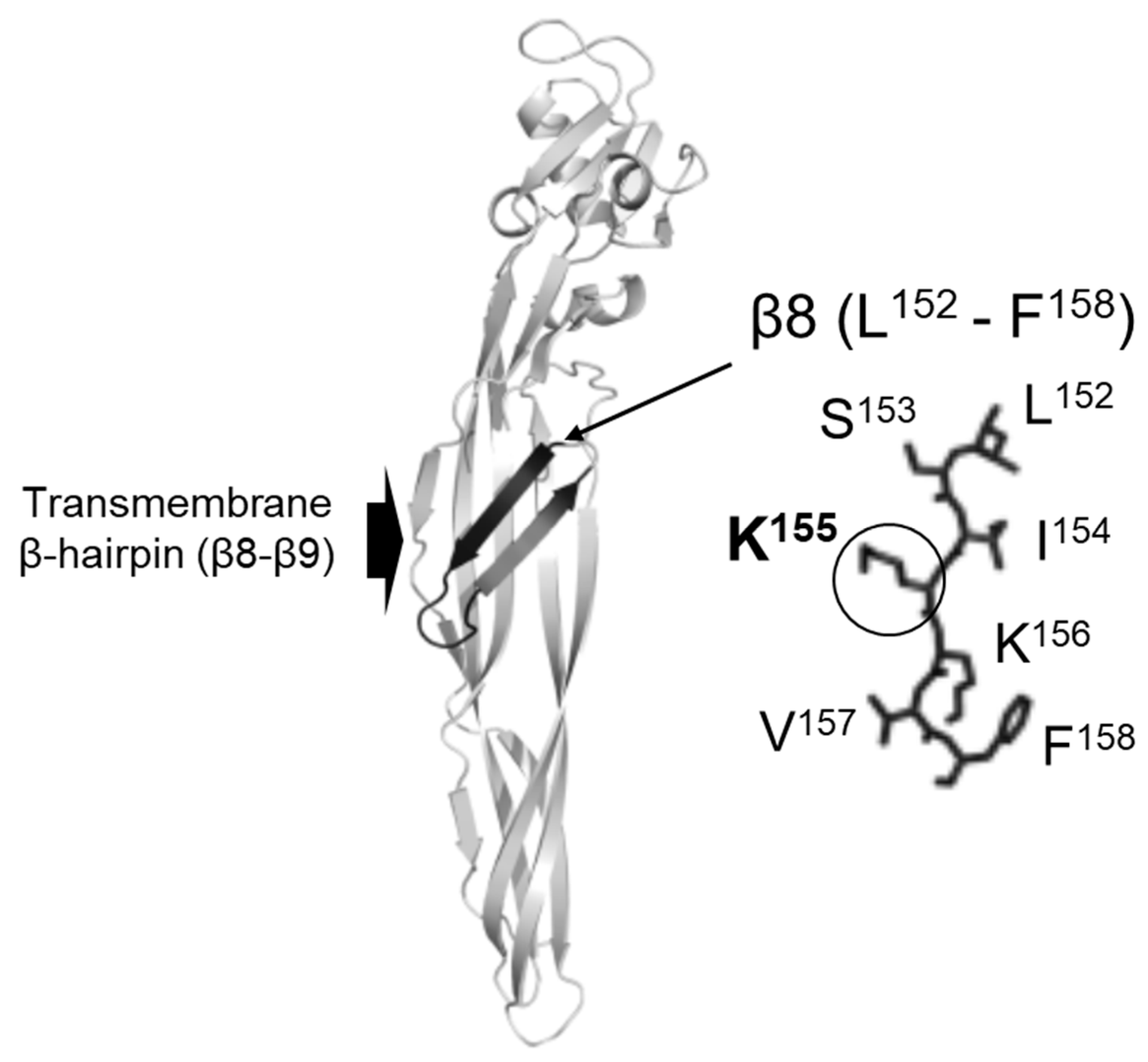
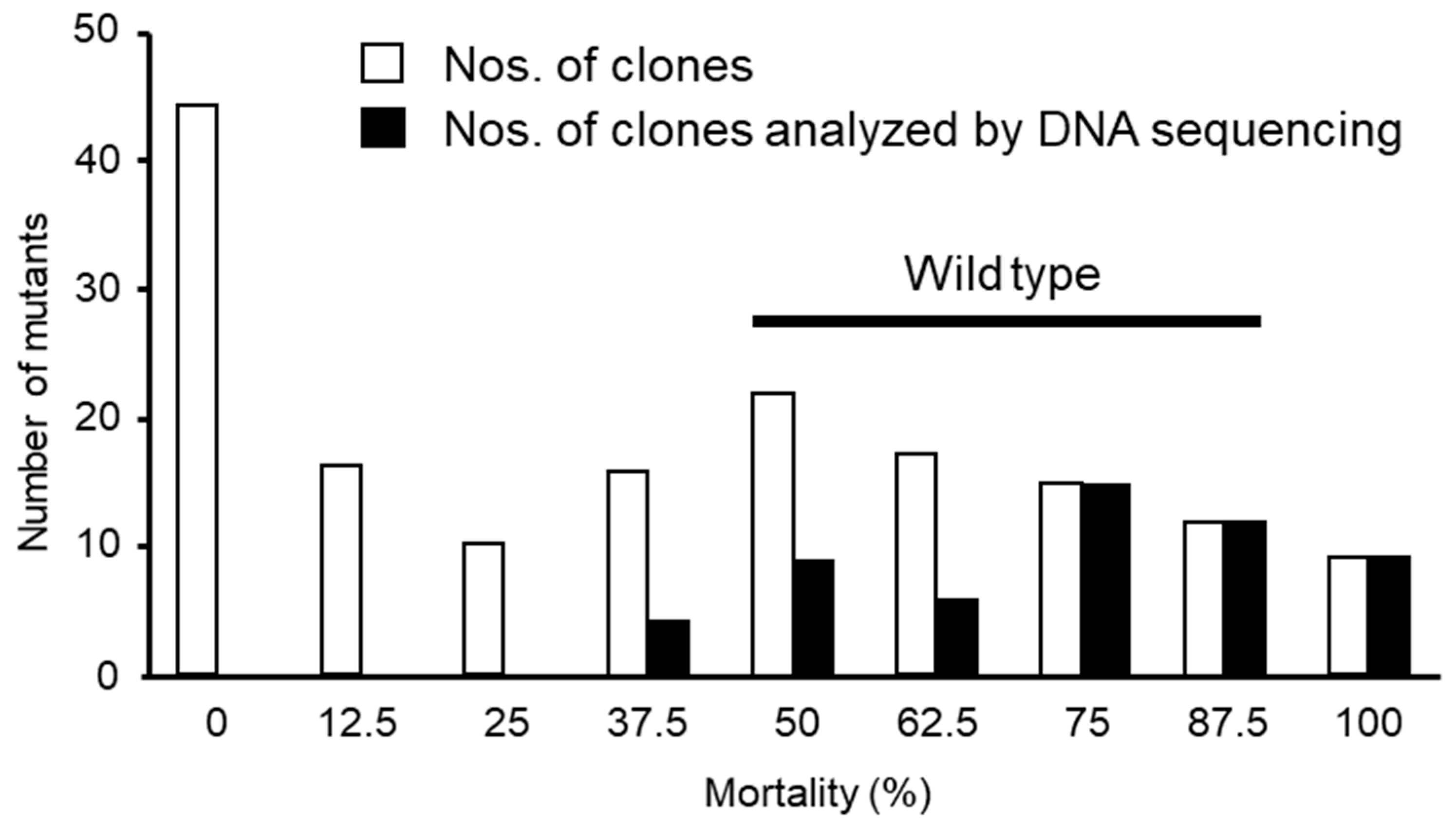
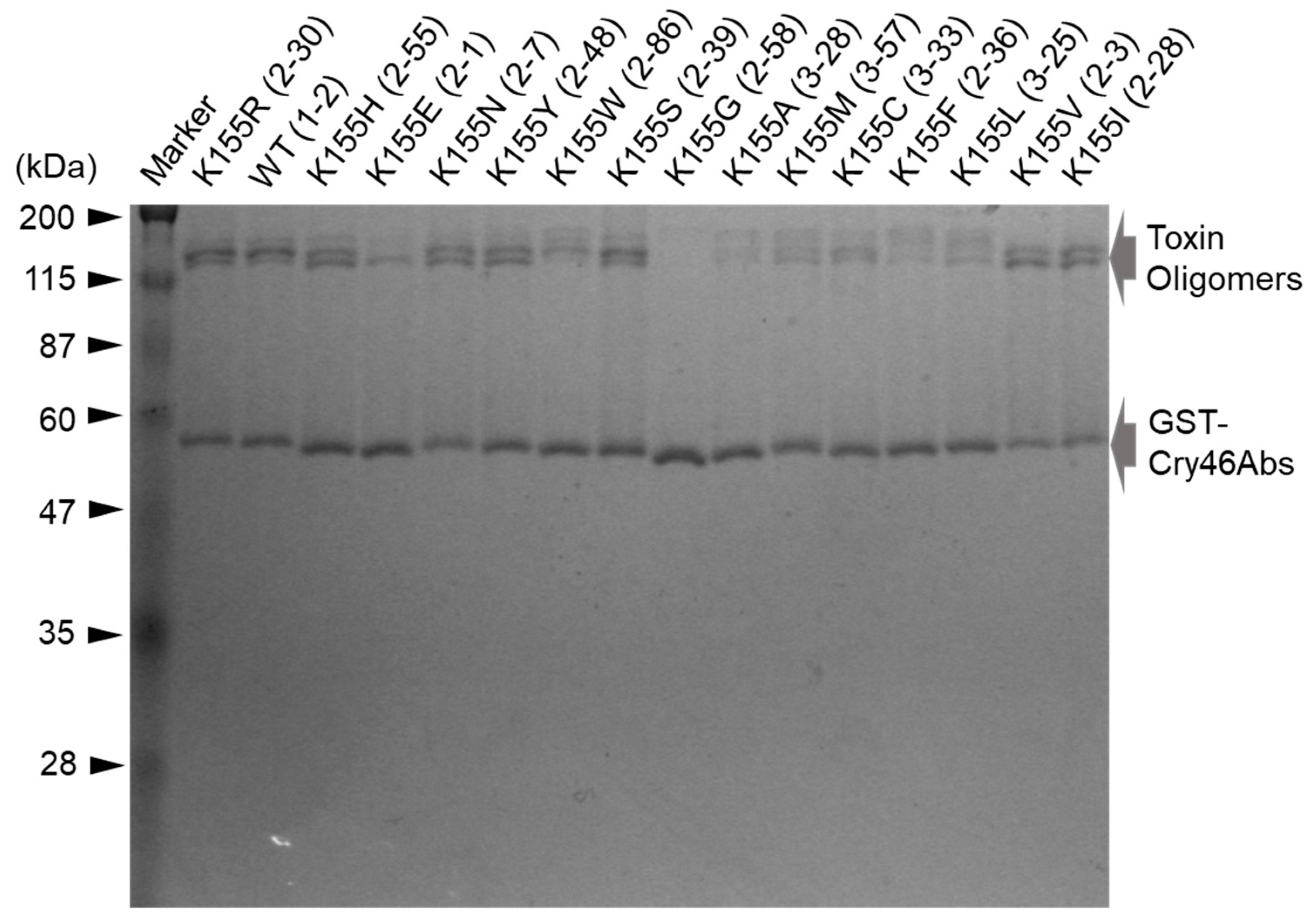
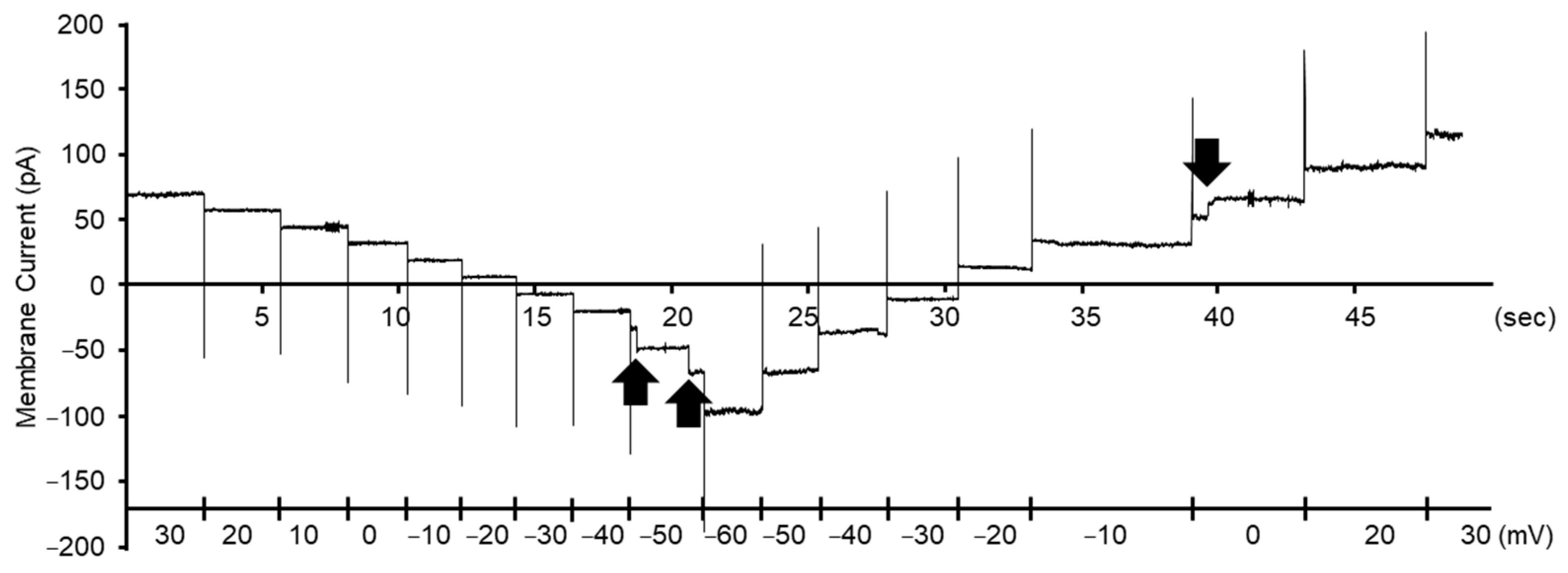
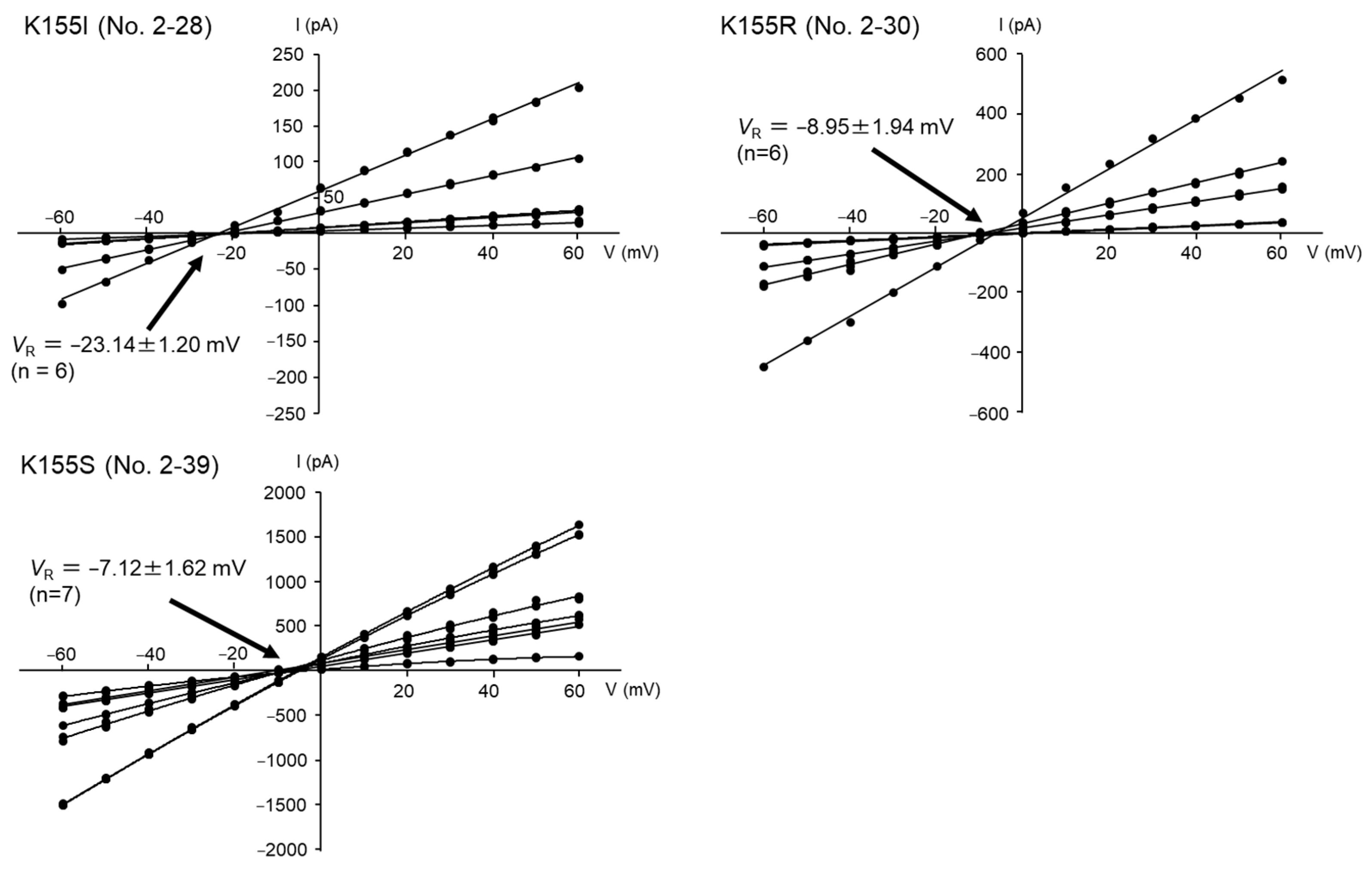
| Amino Acids | Hydropathy Index 1 | Side Chain (Electrical Charge) | Number of Clones | Name |
|---|---|---|---|---|
| R | −4.5 | Positive | 3 | K155R |
| K | −3.9 | 1 | Wild-type | |
| H | −3.2 | 4 | K155H | |
| D | −3.5 | Negative | 0 | - |
| E | −3.5 | 2 | K155E | |
| N | −3.5 | Neutral | 2 | K155N |
| Q | −3.5 | 0 | - | |
| P | −1.6 | 0 | - | |
| Y | −1.3 | 2 | K155Y | |
| W | −0.9 | 3 | K155W | |
| S | −0.8 | 5 | K155S | |
| T | −0.7 | 0 | - | |
| G | −0.4 | 2 | K155G | |
| A | 1.8 | 2 | K155A | |
| M | 1.9 | 1 | K155M | |
| C | 2.5 | 1 | K155C | |
| F | 2.8 | 6 | K155F | |
| L | 3.8 | 5 | K155L | |
| V | 4.2 | 13 | K155V | |
| I | 4.5 | 3 | K155I |
| Mpp46Ab | Replication (n) | Mosquito-Larvicidal Activity | Representative Clone | |
|---|---|---|---|---|
| LC50 (μg/mL) | 95% Confidence Interval | |||
| Wild-type | 18 | 0.51 | 0.48–0.53 | 1–2 |
| K155R | 6 | 0.96 | 0.92–1.00 | 2–30 |
| K155H | 7 | 0.75 | 0.71–0.81 | 2–55 |
| K155E | 7 | 0.04 | 0.03–0.05 | 2–1 |
| K155N | 5 | 0.70 | 0.65–0.74 | 2–7 |
| K155Y | 7 | 0.55 | 0.52–0.58 | 2–48 |
| K155W | 6 | 0.80 | 0.76–0.85 | 2–86 |
| K155S | 9 | 0.92 | 0.87–0.96 | 2–39 |
| K155G | 5 | 0.50 | 0.47–0.54 | 2–58 |
| K155A | 9 | 0.63 | 0.60–0.66 | 3–28 |
| K155M | 8 | 0.43 | 0.40–0.46 | 3–57 |
| K155C | 6 | 0.70 | 0.67–0.73 | 3–33 |
| K155F | 6 | 0.57 | 0.54–0.61 | 2–36 |
| K155L | 7 | 0.61 | 0.57–0.65 | 3–25 |
| K155V | 6 | 0.87 | 0.82–0.92 | 2–3 |
| K155I | 7 | 0.09 | 0.08–0.10 | 2–28 |
Disclaimer/Publisher’s Note: The statements, opinions and data contained in all publications are solely those of the individual author(s) and contributor(s) and not of MDPI and/or the editor(s). MDPI and/or the editor(s) disclaim responsibility for any injury to people or property resulting from any ideas, methods, instructions or products referred to in the content. |
© 2023 by the authors. Licensee MDPI, Basel, Switzerland. This article is an open access article distributed under the terms and conditions of the Creative Commons Attribution (CC BY) license (https://creativecommons.org/licenses/by/4.0/).
Share and Cite
Miyazaki, M.; Asakura, M.; Ide, T.; Hayakawa, T. Random Mutational Analysis Targeting Residue K155 within the Transmembrane β-Hairpin of the Mosquitocidal Mpp46Ab Toxin. Biology 2023, 12, 1481. https://doi.org/10.3390/biology12121481
Miyazaki M, Asakura M, Ide T, Hayakawa T. Random Mutational Analysis Targeting Residue K155 within the Transmembrane β-Hairpin of the Mosquitocidal Mpp46Ab Toxin. Biology. 2023; 12(12):1481. https://doi.org/10.3390/biology12121481
Chicago/Turabian StyleMiyazaki, Midoka, Mami Asakura, Toru Ide, and Tohru Hayakawa. 2023. "Random Mutational Analysis Targeting Residue K155 within the Transmembrane β-Hairpin of the Mosquitocidal Mpp46Ab Toxin" Biology 12, no. 12: 1481. https://doi.org/10.3390/biology12121481
APA StyleMiyazaki, M., Asakura, M., Ide, T., & Hayakawa, T. (2023). Random Mutational Analysis Targeting Residue K155 within the Transmembrane β-Hairpin of the Mosquitocidal Mpp46Ab Toxin. Biology, 12(12), 1481. https://doi.org/10.3390/biology12121481






